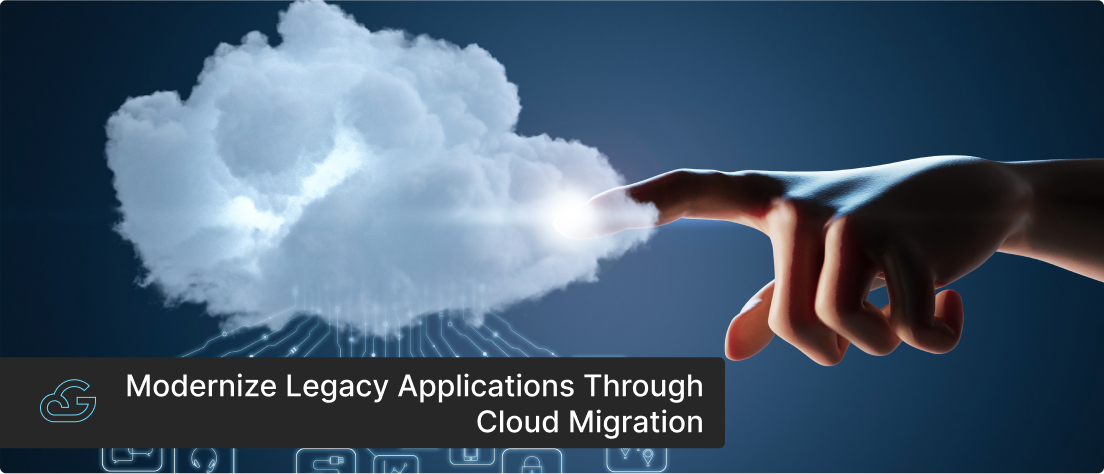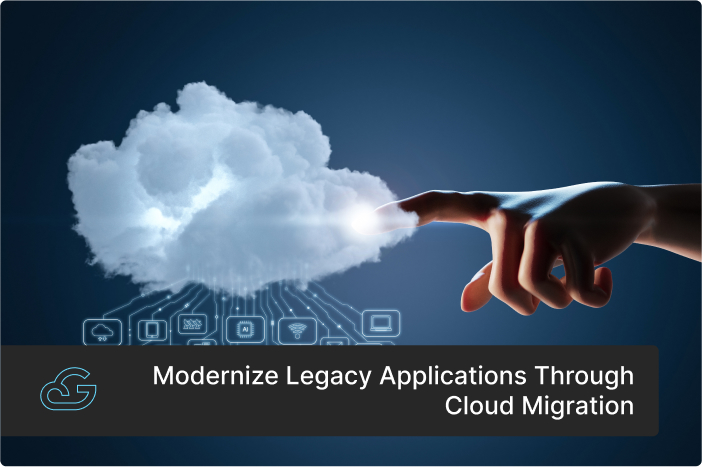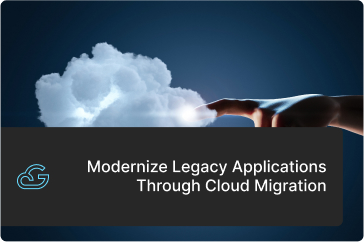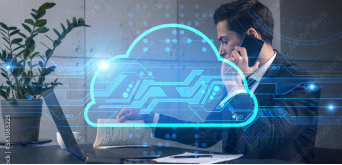Blogs / Migration & Modernization
How to Modernize Legacy Applications Through Cloud Migration?
By
Siju Vincent
Posted: November 27, 2023
• 9 Min
Businesses are constantly seeking ways to streamline operations, reduce costs, and enhance their competitive edge in today's rapidly evolving digital landscape. IBM's research reveals a compelling solution: migrating legacy applications to the cloud. According to their findings, companies that embark on this journey can save an average of 15%-35% on infrastructure costs, 30%-50% on application maintenance and operational costs, and a staggering 74% on hardware, software, and staff costs.
Understanding Legacy Application
Legacy applications, also known as legacy technology, cover a spectrum of applications, platforms, hardware configurations, programming languages and other technologies that have become less popular compared to more sophisticated alternatives. Different factors might cause a software to lose its popularity, resulting in challenges in managing legacy applications.
Challenges in Managing Legacy Applications
The transformation of a functional application into a legacy technology is a gradual process that can have significant repercussions for businesses. A common challenge arises when a legacy application is closely tied to a specific operating system or coding language version. For example, an application designed for Windows 7 may encounter compatibility issues when running on Windows 10, even with advanced techniques. This can result in a substantial effort to maintain support for these older applications.
Recognizing these challenges is the first step towards understanding the importance of legacy modernization.
- Lack of Maintenance: When developers cease to support and update an application, it gradually becomes a relic of the past, unable to adapt to changing business needs and technological advancements.
- No Technical Support: Legacy applications often lack the necessary technical support, leaving users to fend for themselves when issues arise.
- Incompatibility: Legacy apps struggle to keep up as operating systems and coding languages evolve. What worked on a previous version may not function on a modern platform.
- Absence of Updates: Applications that offer no new versions or updates are categorized as "no update available." This stagnation can force users to explore alternatives.
- End of Life (EOL): Legacy apps are frequently built on outdated technologies, programming languages, and frameworks. Vendors discontinue support when these technologies reach their end of life, rendering the applications obsolete.
- Mainframe Applications: Massive data processing once relied heavily on mainframe computers in sectors such as banking and finance. Despite their age, some organizations still rely on these legacy mainframe applications, often running on proprietary operating systems.
Despite their drawbacks, some organizations continue to use legacy applications for specific functionalities, either due to a lack of alternatives or a reluctance to undertake a complex migration process. However, this approach can hinder agility, increase operational costs, and expose the organization to security vulnerabilities.
So, What’s the Solution ahead?
As the demands of the modern business landscape continue to evolve, organizations face a pressing need to adapt and innovate. Migrating legacy applications to the cloud and modernizing your cloud legacy applications have emerged as a strategic move to address these challenges and capitalize on new opportunities.
Benefits of Modernizing Your Legacy Applications
In a rapidly evolving digital landscape, where innovation is a key driver of success, modernizing legacy applications offers a multitude of benefits that can transform your business operations and set you on a path to sustainable growth.
- Work Optimization
- Modernizing legacy applications enables your business to operate faster, more efficiently, and with enhanced effectiveness. This optimization can improve employee morale, reduce operational bottlenecks, and foster a more agile work environment.
- Compliance with Modern Trends
- Legacy application modernization is imperative to keep pace with the rapid evolution of technology and market demands. It ensures that your business remains in sync with the latest trends and can adapt to changing customer expectations.
- Meeting Future Needs
- As your business grows and evolves, so do your needs and requirements. Legacy applications may struggle to keep up with the changing landscape. If you anticipate future growth and an influx of new demands, legacy application modernization becomes a strategic investment.
- Working with New Processes
- Every business that scales and develops encounters new processes that legacy applications may not be equipped to handle. Modernized applications can adapt to new processes, making them an asset rather than a hindrance to growth.
- Avoiding Problems and Failures
- Modernizing your company's legacy applications can help configure internal systems for smooth, uninterrupted performance. Improved application performance streamlines workflow processes and accelerates your journey towards achieving company objectives.
- Cost Reduction
- Legacy application modernization enables you to extend the life and functionality of your current software investments while avoiding the high costs associated with replacing them.
Approaches to Legacy Application Migration
As organizations embark on their journey to modernize legacy applications, they are presented with various approaches to legacy system cloud migration. Each approach comes with its own set of advantages and challenges, allowing businesses to choose the one that aligns best with their unique needs and goals.
Here are the three primary approaches to legacy application migration:
- Rehosting (a.k.a. "Lift and Shift")
- Refactoring
- Replatforming
Rehosting refers to the process of transferring applications to a cloud environment while making minimal alterations to the code or structure. Although it offers an uncomplicated transition, it is essential to understand both the benefits and drawbacks involved.
| Upsides of Rehosting | Downsides of Rehosting |
|---|---|
| 1) The Quickest & Easiest Approach | 1) Preliminary Thorough Performance Testing Required |
| 2) No Changes to Code and Architecture | 2) No Long-term Scalability |
Refactoring involves migrating legacy applications to the public cloud while simultaneously making substantial changes to the application's architecture using native cloud technologies. This approach offers sustainability, scalability, and remote accessibility but requires significant time and investment.
| Upsides of Refactoring | Downsides of Refactoring |
|---|---|
| 1) The Most Sustainable Approach | 1) Long-term Investments Required |
| 2) Great Scalability is Guaranteed | 2) Significant Code Changes |
Replatforming strikes a balance between rehosting and refactoring. It involves minor changes to the code and architecture while migrating legacy applications to the cloud, making it a quicker and less expensive option.
| Upsides of Replatforming | Downsides of Replatforming |
|---|---|
| 1) Minor Changes to Code and Architecture | 1. Doesn't Solve All Issues |
| 2) The Client Side Remains Practically the Same | |
| 3) A Great Starting Point |
You Might Like: Best Cloud Migration Tools And Services To Choose In 2023
Steps to Modernize Legacy Applications Through Cloud Migration
Modernizing legacy applications through cloud migration is a strategic endeavor that requires careful planning and execution. To ensure a successful transformation, consider the following steps/checklists in your migration journey:
Step 1: Conduct a SWOT Analysis
Any successful transformation begins with a thorough analysis of your current state and the challenges and opportunities ahead. Conduct a SWOT analysis specific to your legacy migration project:
- Strengths: Identify features and functions within your legacy applications that can be enhanced or repurposed in the cloud environment.
- Weaknesses: Recognize software components, dependencies, or bottlenecks that may impede the migration process. Understanding these limitations is critical for planning.
- Opportunities: Assess the potential benefits that cloud migration can bring to your organization, such as scalability, cost savings, and improved agility.
- Threats: Acknowledge the risks associated with legacy data migration, including data integrity, security, and compatibility issues. Develop strategies to mitigate these risks.
Step 2: Assess Your Current Infrastructure
Before starting your migration, it's essential to understand your existing environment thoroughly. Use multifunctional tools, such as the Microsoft Assessment & Planning Toolkit, to gather key information:
- Infrastructure Capacity: Evaluate your infrastructure's capacity to ensure it can support cloud-based applications and workloads.
- Performance & Data Requirements: Analyze your legacy applications' performance metrics and data requirements to inform migration decisions.
- Network Architecture: Examine your network architecture to identify any potential bottlenecks or areas that require optimization for efficient data transfer to the cloud.
Step 3: Define the Legacy System Migration Strategy
With a clear understanding of your environment and SWOT analysis results, define a comprehensive migration strategy. Choose one of the approaches mentioned earlier (rehosting, refactoring, or re-platforming) that aligns with your migration requirements and capabilities.
Additionally, during this stage:
- Documentation: Develop detailed documentation for the entire migration workflow, including timelines, roles, responsibilities, and key milestones.
- Containerization: If applicable, decide on the containerization process for migrating legacy applications into Docker containers. Containerization can enhance portability and scalability.
- Data Migration: Recognize that data migration from legacy systems to a modern database can be challenging. Consider leveraging external consulting services if necessary to ensure a smooth data migration process.
Step 4: Implement a Pilot Migration
Before committing to a full-scale migration, conduct a pilot migration. This phase allows you to assess the chosen migration strategy's effectiveness and identify prior to any potential issues. Key activities in this step include:
- Testing: Thoroughly test the migration process, from data transfer to application functionality, to uncover any errors or complications.
- Validation: Validate that the pilot migration meets your objectives and aligns with your organization's goals.
- Feedback Collection: Gather feedback from stakeholders and technical teams involved in the pilot migration to address any issues and make necessary improvements.
Step 5: Migrate and Optimize
Once the pilot migration is successful and any identified issues are resolved, proceed with the full-scale migration. Following the established migration strategy, migrate your legacy applications to the cloud environment.
After migration, the work doesn't stop. Continuously monitor the system's performance, gather feedback from users, and optimize the cloud-based applications as needed. Regularly assess whether the migration is meeting your organization's goals and make adjustments as necessary to ensure long-term success.
Cloud Migration Checklist: Things to Consider
Migrating legacy applications to the cloud is a complex process that demands meticulous planning and execution. To ensure a smooth transition and minimize potential challenges, consider the following cloud application migration checklist:
- Upkeep the Current and New Versions: Prioritize optimization of both your current legacy systems and the new cloud-based versions. Ensure that your legacy systems are up-to-date, well-maintained, and free from glitches.
- Perform Continuous Integration and Delivery (CI/CD): Implement continuous integration and delivery practices to streamline your development and deployment processes. CI/CD encourages frequent, incremental updates rather than large, infrequent changes.
- Map the Dependencies: Create a comprehensive dependency map that outlines the relationships between various software components within your applications. Mapping them allows you to migrate the right dependencies in the correct order, ensuring that the migrated system functions seamlessly. Identify areas where hybrid integration may be necessary for a smooth operation.
- Test and Slowly Expand: Adopt a testing approach that involves migrating and testing in batches. Gradually expand the migration scope as you gain confidence in the stability and functionality of the cloud-based applications.
- Address Issues as They Arise: Acknowledge that issues are likely to arise during the migration process. Implement a proactive approach to address these issues promptly as they emerge, rather than deferring them to the end of the migration project.
- Migrate One at a Time: Opt for a structured and organized migration approach by focusing on one aspect or application at a time. Migrating components or functions one by one reduces data loss and simplifies migration.
The Need for a Cloud Migration Consultant
A successful upgrade of legacy applications to the cloud requires expertise and guidance from a seasoned cloud migration consulting expert. When considering the services of a consultant, it is crucial to evaluate their portfolio, client testimonials, and technical skills. But why exactly do you need a consultant for your cloud migration project? Here are compelling reasons:
- Business Analysis
- Current and Future Business Needs: What are your business's immediate and long-term needs that the modernization aims to address?
- Organizational and Departmental Challenges: What specific issues must be addressed at both the organizational and departmental levels to ensure a smooth transition?
- Growth Opportunities: What opportunities can be harnessed through modernization to facilitate business growth and expansion?
- Customer Support Enhancement: How can the modernization of your applications improve customer support and satisfaction?
- Interface Enhancement
- Best Design Practices: Recommending the best design practices and keeping you updated on the latest UI/UX trends.
- Alignment with Modern Trends: Advising on aligning the interface changes with contemporary design trends.
- Development
- Release
- Support
A critical initial step in the application modernization process is conducting a comprehensive business analysis. A skilled consultant can assist by guiding you through a series of crucial questions:
The next step is upgrading your apps' UI and UX. If your legacy application lacks aesthetic appeal, improving the design can improve user experience and friendliness.
A proficient consultant can guide you through this process, including:
During the development phase, careful consideration must be given to the technical stack used for modernization. A skilled consultant can help you make informed decisions about the technology stack and development approach.
Furthermore, a consultant may recommend a gradual development strategy. For instance, you can develop and test specific modules before proceeding to the next set, ensuring that each step is successful and aligns with your requirements and specifications.
The release stage comes into play once the modernization process is nearing completion. Showcasing the modernized application to all relevant team members and consultants is crucial. This phase includes discussions about the new benefits and functionalities introduced through modernization.
Modernization efforts do not conclude with the release. Over time, your organization may undergo changes, and the application may require updates or modifications. A capable consultant is indispensable for providing ongoing support. They can ensure that the application continues to function optimally, address any emerging issues, and promptly fix potential bugs as they arise.
Gsoft Cloud: Your Efficient Cloud Migration Partner
At Gsoft Cloud, one of the best cloud computing service providers, we offer a seamless three-step approach to migrate and modernize your legacy applications, ensuring they thrive in the cloud environment. First, we Assess your unique needs and objectives, conducting thorough risk assessments and cost analyses while helping you select the ideal cloud service models and providers.
Next, we expertly Migrate your applications and data, offering various strategies from rehosting to rebuilding, all while ensuring rigorous testing, security, and compliance. We make sure your migration is smooth and reliable.
Finally, our Modernization phase unlocks the full potential of your applications in the cloud. We refactor, optimize, and integrate cloud-native services, focusing on scalability, resilience, and continuous improvement. Gsoft Cloud is your cloud migration services partner for a successful cloud journey, from Assess to Migrate to Modernize.
Conclusion
In today's fast-paced digital landscape, modernizing legacy applications through cloud migration is not just a choice but a necessity for business growth and agility.
At Gsoft Cloud, we understand the challenges and opportunities this transformation presents. Our comprehensive three-step approach ensures a seamless and successful migration process, empowering your applications to thrive in the cloud.
Contact us today to start your modernization journey with confidence. Together, we'll unlock the full potential of your legacy applications in the cloud.


Get Know More About Our Services and Products
Reach to us if you have any queries on any of our products or Services.











